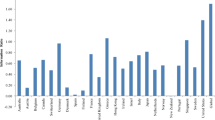Abstract
We analyze common factors that affect returns on S&P 500 index options and find that 93% of the variation in option returns can be explained by three factors, which respectively account for 87%, 4%, and 2% of the variation in option returns. Furthermore, we test diffusion option pricing models by using mean–variance spanning properties implied in the models. The spanning tests reject one-factor diffusion models, as well as the hypothesis that the underlying asset and an equally weighted option index span options. Our results fail to reject that the underlying asset and an at-the-money option can span out-of-the-money options, but does reject that they span in-the-money options.
Similar content being viewed by others
References
Bakshi G., Cao C., Chen Z. (1997). Empirical performance of alternative option pricing models. Journal of Finance 52:2003–2049
Bakshi G., Cao C., Chen Z. (2000). Do call prices and the underlying stock always move in the same direction?. Review of Financial Studies 13:549–584
Bakshi G., Kapadia N., Madan D. (2003). Stock return characteristics, skew laws, and differential pricing of individual equity options. Review of Financial Studies 16:101–143
Bates D. (1991). The crash of 87: Was it expected? The evidence from options markets. Journal of Finance 46:1009–1044
Bates D. (1996). Jumps and stochastic volatility: Exchange rate processes implicit in deutschemark options. Review of Financial Studies 9:69–108
Bates D. (2000). Post-87 crash fears in S&P 500 futures options. Journal of Econometrics 94:181–238
Bekaert G., Urias M. (1996). Diversification, integration and emerging market closed-end funds. Journal of Finance 51:835–869
Black F., Scholes M. (1973). The pricing of options and corporate liabilities. Journal of Political Economy 81:637–659
Bondarenko, O. (2003). Why are put options so expensive? Working paper, University of Illinois at Chicago.
Buraschi A., Jackwerth J. (2001). The price of a smile: Hedging and spanning in option markets. Review of Financial Studies 14:495–527
Chernov M., Ghysels E. (2000). A study towards a unified approach to the joint estimation of objective and risk-neutral measures for the purpose of option valuation. Journal of Financial Economics 56:407–458
Cochrane J., Saa-Requejo J. (2000). Beyond arbitrage: Good-deal asset price bounds in incomplete markets. Journal of Political Economy 108:79–119
DeSantis, G. (1995). Volatility bounds for stochastic discount factors: Tests and implications from international stock returns. Working paper, University of Southern California.
Dumas B., Fleming J., Whaley R. (1998). Implied volatility function: Empirical tests. Journal of Finance 53:2059–2106
Ferson, W. (1995). Theory and empirical testing of asset pricing models in finance. In R. Jarrow, V. Maksimovic, & W. Ziemba (Eds.), Handbooks in Operations Research and Management Science (pp. 145–200). Elsevier.
Ferson W., Foerster S. (1994). Finite sample properties of generalized methods of moments tests of conditional asset pricing models. Journal of Financial Economics 36:29–56
French K., Schwert G.W., Stambaugh R. (1987). Expected stock return and volatility. Journal of Financial Economics 19:3–30
Grinblatt M., Titman S. (1987). The relation between mean–variance efficiency and arbitrage pricing. Journal of Business 60:97–112
Hansen L. (1982). Large sample properties of generalized Method of moment estimators. Econometrica 50:1029–1054
Hansen L., Jagannathan R. (1991). Implications of security market data for models of dynamic economies. Journal of Political Economy 99:225–262
Heston S. (1993). A closed-form solution for options with stochastic volatility with applications to bond and currency options. Review of Financial Studies 6:327–343
Huberman G., Kandel S., Stambaugh R. (1987). Mimicking portfolios and exact arbitrage pricing. Journal of Finance 42:1–9
Huberman G., Kandel S. (1987). Mean–variance spanning. Journal of Finance 42:373–388
Hull J., White A. (1987). The pricing of options with stochastic volatilities. Journal of Finance 42:281–300
Ingersoll, J. (1987). Theory of financial decision making. Rowman and Littlefield.
Jones C. (2006). A nonlinear factor analysis of S&P 500 index option returns. Journal of Finance 41:2325–2363
Kan, R., & Zhou, G. (2001). Tests of mean–variance spanning. Working paper, University of Toronto and Washington University.
Knez P., Litterman R., Scheinkman J. (1994). Explorations into factors explaining money market returns. Journal of Finance 49:1861–1882
Lehmann B., Modest D. (1988). The empirical foundations of the arbitrage pricing theory. Journal of Financial Economics 21:213–254
Longstaff F. (1995). Option pricing and the martingale restriction. Review of Financial Studies 8:1091–1124
Madan D., Carr P., Chang E. (1998). The variance gamma process and option pricing. European Finance Review 2:79–105
Melino A., Turnbull S. (1990). Pricing foreign currency options with stochastic volatility. Journal of Econometrics 45:239–265
Merton R. (1973). Theory of rational option pricing. Bell Journal of Economics and Management Science 4:141–183
Newey W., West K. (1987). A simple, positive semi-definite, heteroskedasticity and autocorrelation consistent covariance matrix. Econometrica 55:703–708
Rubinstein M. (1994). Implied binomial trees. Journal of Finance 49:771–818
Schwert G.W. (1989). Why does stock market volatility change over Time?. Journal of Finance 44:1115–1153
Schwert G.W. (1990). Stock market volatility and the crash of ’87. Review of Financial Studies 3:77–102
Scott L. (1987). Option pricing when the variance changes randomly: Theory, estimators, and applications. Journal of Financial and Quantitative Analysis 22:419–438
Scott L. (1997). Pricing stock options in a jump-diffusion model with stochastic volatility and interest rates: Application of fourier inversion methods. Mathematical Finance 7:413–426
Stein E., Stein J. (1991). Stock price distributions with stochastic volatility. Review of Financial Studies 4:727–752
Whaley R. (1982). Valuation of american call options on dividend paying stocks. Journal of Financial Economics 10:29–58
White H. (1980). A heteroskedasticity-consistent covariance matrix estimator and a direct test for heteroskedasticity. Econometrica 48:817–838
Wiggins J. (1987). Option values under stochastic volatilities. Journal of Financial Economics 19:351–372
Author information
Authors and Affiliations
Corresponding author
Rights and permissions
About this article
Cite this article
Cao, C., Huang, JZ. Determinants of S&P 500 index option returns. Rev Deriv Res 10, 1–38 (2007). https://doi.org/10.1007/s11147-007-9015-5
Published:
Issue Date:
DOI: https://doi.org/10.1007/s11147-007-9015-5
Keywords
- Option returns
- Factor analysis
- Option implied volatility
- Equally weighted option index
- Mean–variance spanning




